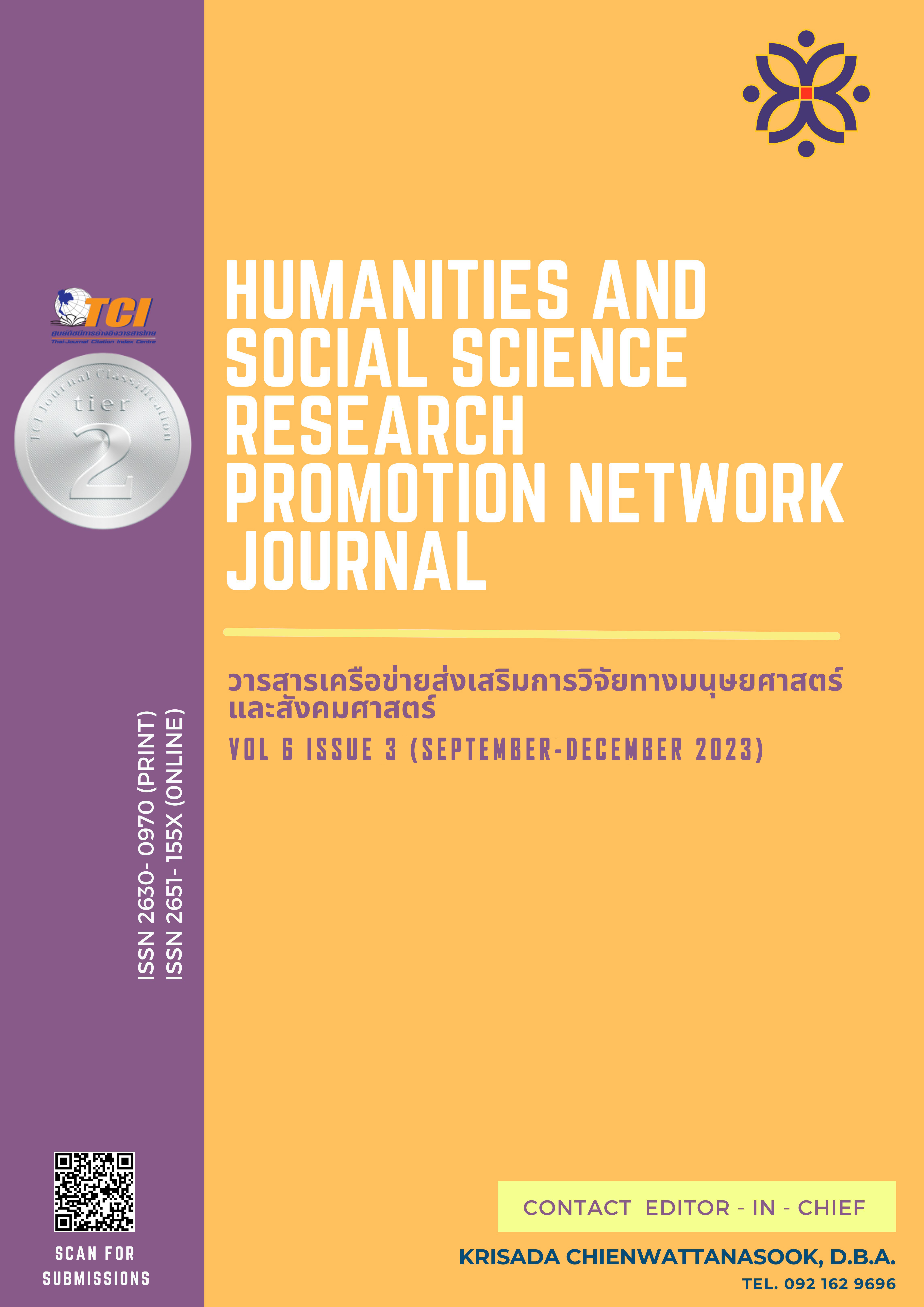ปัจจัยที่ส่งผลต่อความตั้งใจที่จะเลือกใช้บริการโซเชียลแบงก์กิ้ง กรณีศึกษา ไลน์บีเคของกลุ่มผู้บริโภคเจเนอเรชันวาย
คำสำคัญ:
โซเชียลแบงก์กิ้ง , ความตั้งใจที่จะเลือกใช้บริการ , แบบจำลอง UTAUTบทคัดย่อ
ด้วยยุคสมัยการบริโภคที่เปลี่ยนแปลง ส่งผลให้มีการพัฒนาเทคโนโลยีทางการเงินเพื่อตอบสนองต่อความต้องการและความสะดวกสบายของมนุษย์ที่เพิ่มมากขึ้น เพื่อเป็นแนวทางในการศึกษาความต้องการและพฤติกรรมการเลือกใช้งานเทคโนโลยีของผู้บริโภค งานวิจัยนี้จึงมีวัตถุประสงค์เพื่อศึกษาปัจจัยการยอมรับและการใช้เทคโนโลยี ปัจจัยส่วนบุคคล และปัจจัยทางเทคโนโลยีที่ส่งต่อความตั้งใจที่จะเลือกใช้บริการโชเชียลแบงก์กิ้ง กรณีศึกษา ไลน์บีเคของผู้บริโภคเจเนอเรชันวาย โดยมีการใช้แบบสอบถามเก็บรวบรวมข้อมูลตัวอย่างช่วงอายุ 21-37 ปี ทั้งหมด 378 คน โดยใช้วิธีการสุ่มตัวอย่างแบบเฉพาะเจาะจง เนื่องจากผู้ศึกษาวิจัยได้กำหนดผู้กรอกแบบสอบถามเป็นกลุ่มผู้ที่มีการรับรู้ข้อมูลเกี่ยวกับการให้บริการโชเชียลแบงก์กิ้งของไลน์บีเคในกลุ่มเจเนอเรชันวาย เพื่อให้ได้มาซึ่งข้อมูลที่สอดคล้องกับวัตถุประสงค์ ซึ่งผลการวิจัยพบว่า ปัจจัยที่ส่งผลต่อความตั้งใจเลือกใช้บริการ ได้แก่ ความคาดหวังในประสิทธิภาพ อิทธิพลทางสังคม สิ่งอํานวยความสะดวกในการใช้งาน การรับรู้ของผู้บริโภค นวัตกรรมส่วนบุคคล คุณภาพระบบ และความเป็นส่วนตัวและความปลอดภัย อย่างมีนัยสําคัญทางสถิติที่ระดับ .05 ส่งผลต่อการเลือกใช้บริการทางเทคโนโลยีของแอปพลิเคชันไลน์บีเคและปัจจัยที่ไม่ส่งผลต่อการเลือกใช้บริการทางเทคโนโลยีของแอปพลิเคชันไลน์บีเค คือ ความคาดหวังในความพยายาม อย่างมีนัยสําคัญทางสถิติที่ระดับ .05
เอกสารอ้างอิง
คณะวิจัย TDRI. (2020). สังคมไร้เงินสดและเงินดิจิทัล พยุงและช่วยฟื้นเศรษฐกิจในช่วงโควิด-19. https://tdri.or.th/2020/06/covid-40/
ธนาคารแห่งประเทศไทย. (2023). ปรีดี ดาวฉาย กับการปรับตัวของธุรกิจธนาคารเพื่อนำพาความเข้มแข็งสู่สังคมไทย. https://www.bot.or.th/Thai/BOTMagazine/Pages/256302Relax_KhunPredee.aspx
สุวนัทธ์ สิทธิธรรม และ กมลพรรณ แสงมหาชัย. (2565). ในการยอมรับการใช้ระบบอีวอลเลทที่มีต่อพฤติกรรมการทำธุรกรรมทางการเงิน. วารสารบริหารธุรกิจและการบัญชี มหาวิทยาลัยขอนแก่น, 6(1), 138-154.
Agarwal, R., & Prasad, J. (1998). A conceptual and operational definition of personal innovativeness in the domain of information technology. Information systems research, 9(2), 204-215.
Ajzen, I., & Fishbein, M. (1975). A Bayesian analysis of attribution processes. Psychological bulletin, 82(2), 261.
Anshori, M. Y., Karya, D. F., & Gita, M. N. (2022). A study on the reuse intention of e-commerce platform applications: security, privacy, perceived value, and trust. Journal of Theoretical and Applied Management (Jurnal Manajemen Teori Dan Terapan), 15(1), 13–24.
Basheer, M. F., Hussain, T., Hussan, S. G., & Javed, M. (2017). Impact of customer awareness, competition and interest rate on growth of Islamic banking in Pakistan. International Journal of Scientific & Technology Research, 4(8), 33-40.
Bhattacherjee, A. (2001). Understanding information systems continuance: An expectation-confirmation model. MIS Quarterly, 25(3), 351-370.
Bohlin, E., Shaikh, A. A., & Hanafizadeh, P. (2018). Social network banking: a case study of 100 leading global banks. International journal of e-business research, 14(2), 1-13.
Bouteraa, M., Hisham, R. R. I. R., & Zainol, Z. (2022). Bank Customer Green Banking Technology Adoption: A Sequential Exploratory Mixed Methods Study. In Handbook of Research on Building Greener Economics and Adopting Digital Tools in the Era of Climate Change (pp. 64-102). IGI Global.
Cronbach, L. J. (1951). Coefficient alpha and the internal structure of tests. Psychometrika, 16(3), 297-334.
Cujrnewmedia. (2012). สื่อเก่าในสื่อใหม่: ในรอยประวัติศาสตร์เดิม. https://cujrnewmedia.wordpress.com/tag/technology-determinism-theory/
Davis, F. D., Bagozzi, R. P., & Warshaw, P. R. (1992). Extrinsic and intrinsic motivation to use computers in the workplace 1. Journal of applied social psychology, 22(14), 1111-1132.
DeLone, W. H., & McLean, E. R. (1992). Information systems success: The quest for the dependent variable. Information systems research, 3(1), 60-95.
DeLone, W. H., & McLean, E. R. (2003). The DeLone and McLean model of information systems success: a ten-year update. Journal of management information systems, 19(4), 9-30.
Glavee-Geo, R., Shaikh, A. A., & Karjaluoto, H. (2017). Mobile banking services adoption in Pakistan : are there gender differences?. International Journal of Bank Marketing, 35(7), 1088-1112.
Gurung, A. (2006). Empirical investigation of the relationship of privacy, security and trust with behavioral intention to transact in e-commerce. The University of Texas at Arlington.
Hernandez-Ortega, B. (2011). The role of post-use trust in the acceptance of a technology: Drivers and consequences. Technovation, 31(10-11), 523-538.
Kaewratsameekul, W. (2018). An examination of behavioral intention to use contactless mobile payment: Rapid transit system in Thailand. Science, Engineering and Health Studies, 12(2), 85-101.
Kline, R.B. (2011). Principles and Practice of Structural Equation Modeling. Guilford Press.
Kolsaker, A., & Payne, C. (2002). Engendering trust in e‐commerce: a study of gender‐based concerns. Marketing intelligence & planning, 20(4), 206-214.
Lee, M. S. (2019). Effects of personal innovativeness on mobile device adoption by older adults in South Korea: the moderation effect of mobile device use experience. International Journal of Mobile Communications, 17(6), 682-702.
LINE BK. (2564). LINE BK ประกาศความสำเร็จด้วยยอดผู้ใช้บริการทะลุ 1 ล้านรายใน 2 เดือน. https://www.linebk.com/th/news/detail/line-bk-hits-1-million-users-within-2-months-after-launch/
Moore, G. C., & Benbasat, I. (1991). Development of an instrument to measure the perceptions of adopting an information technology innovation. Information systems research, 2(3), 192-222.
Naranjo-Zolotov, M., Oliveira, T., & Casteleyn, S. (2018). Citizens’ intention to use and recommend e-participation: Drawing upon UTAUT and citizen empowerment. Information Technology & People, 32(2), 364-386.
Parusheva, S. (2017). Social Media Banking Models: a Case Study of A Practical Implementation in Banking Sector. Ikonomicheski Izsledvania, 3, 125-141.
Riquelme, H. E., & Rios, R. E. (2010). The moderating effect of gender in the adoption of mobile banking. International Journal of bank marketing, 28(5), 328-341.
Rogers, M. (1983). Diffusion of Innovation (3rd ed.). The Free Press.
Venkatesh, V., & Davis, F. D. (2000). A theoretical extension of the technology acceptance model: Four longitudinal field studies. Management science, 46(2), 186-204.
Venkatesh, V., Morris, M. G., Davis, G. B., & Davis, F. D. (2003). User acceptance of information technology: toward a unified view. MIS Quarterly, 27(3), 425-478.
Venkatesh, V., Thong, J. Y., & Xu, X. (2012). Consumer acceptance and use of information technology: extending the unified theory of acceptance and use of technology. MIS Quarterly, 36, 157-178.
Yoon, H. S., & Steege, L. M. B. (2013). Development of a Quantitative Model of the Impact of Customers’ Personality and Perceptions on Internet Banking Use. Computers in Human Behavior, 29(3), 1133-1141.
Zhou, T., Lu, Y., & Wang, B. (2010). Integrating TTF and UTAUT to explain mobile banking user adoption. Computers in human behavior, 26(4), 760-767.
ดาวน์โหลด
เผยแพร่แล้ว
รูปแบบการอ้างอิง
ฉบับ
ประเภทบทความ
สัญญาอนุญาต
ลิขสิทธิ์ (c) 2023 กุลณัฐ หัตถปนิตย์, กรชนก แซมหิรัญ, นรีกานต์ คนโททอง, นัทธมน สมตั้งมั่น, จารุพร ตั้งพัฒนกิจ

อนุญาตภายใต้เงื่อนไข Creative Commons Attribution-NonCommercial-NoDerivatives 4.0 International License.
บทความที่ได้รับการตีพิมพ์เป็นลิขสิทธิ์ของ ผู้เขียน
ทัศนะและความคิดเห็นที่ปรากฏในบทความในวารสารเครือข่ายส่งเสริมการวิจัยทางมนุษยศาสตร์และสังคมศาสตร์จะถือเป็นความรับผิดชอบของผู้เขียนบทความนั้น และไม่ถือเป็นทัศนะและความรับผิดชอบของกองบรรณาธิการ








